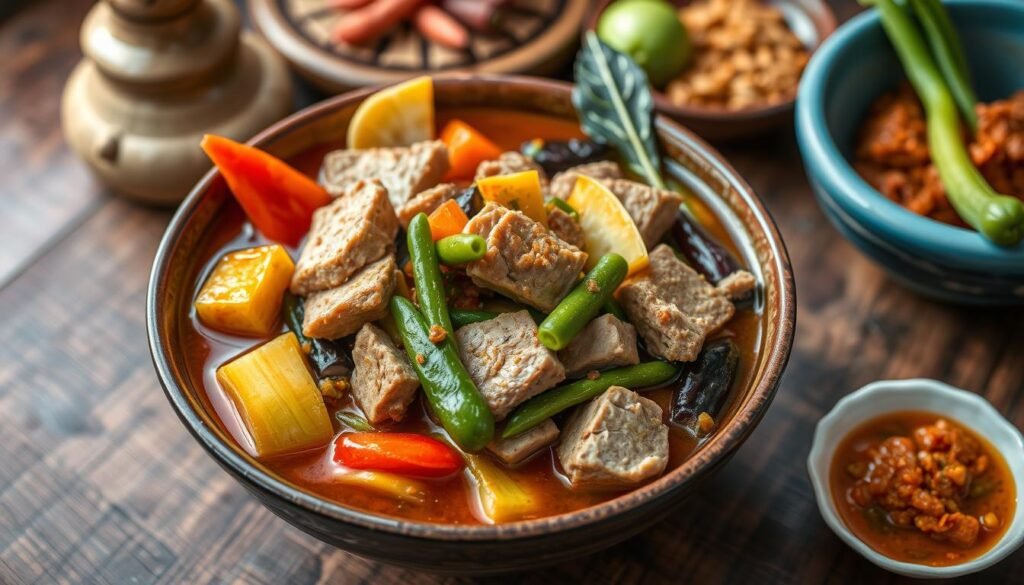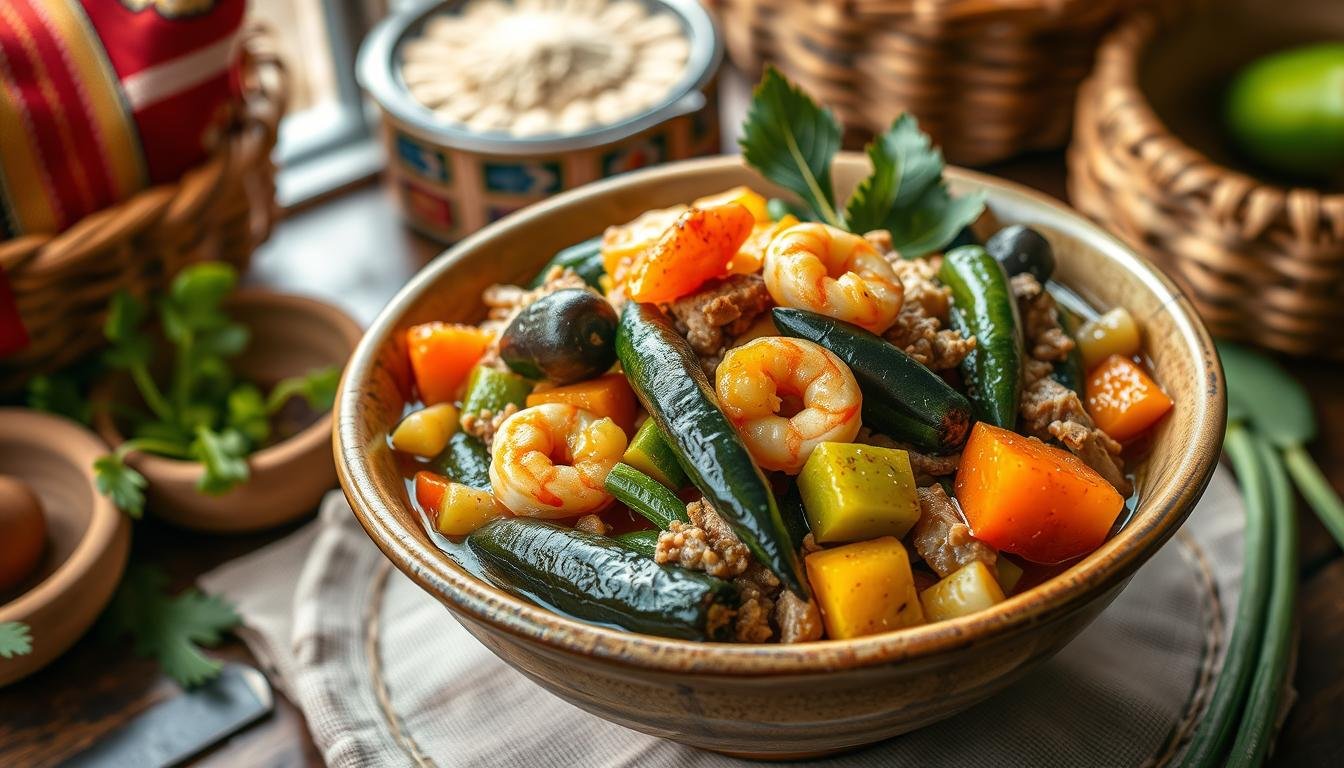What makes Pinakbet, a traditional Filipino vegetable stew, a staple in many Filipino households? It has become a beloved food around the world. This dish is made with various vegetables like bitter melon, eggplant, and squash. It’s cooked in a savory sauce that’s both delicious and nutritious.
Pinakbet is quick to cook, taking only 30 to 45 minutes. It’s also great for those who follow vegetarian or vegan diets. It’s often served with steamed rice, a common pairing in Filipino meals. Its rich flavor and health benefits have made Pinakbet a favorite in many homes.
Key Takeaways
- Pinakbet is a traditional Filipino vegetable stew made with a variety of vegetables and a savory sauce.
- The dish is relatively quick to cook, with a cooking time of 30 to 45 minutes.
- Pinakbet is a nutritious food, low in fat and rich in dietary fiber, and can be adapted for vegetarian or vegan diets.
- The dish is commonly served with steamed rice and is a staple in many Filipino households.
- Pinakbet has become a beloved food around the world, and its unique flavor and numerous health benefits make it a great addition to a healthy diet.
- Pinakbet is a versatile dish that can be made with locally sourced vegetables, which enhances its flavor and freshness.
What is Pinakbet?
Pinakbet is a traditional Filipino vegetable stew from the northern Philippines. It’s made with vegetables like bitter melon, eggplant, okra, squash, and string beans. These are cooked in a tasty sauce.
The sauce has shrimp paste, garlic, ginger, and spices. This mix gives Pinakbet its unique taste. It’s a healthy and tasty recipe for a nutritious meal.
Definition and Origin
Pinakbet comes from “pinakebbet,” meaning “shrunk” or “shriveled” in Ilocano. It’s a favorite in the Ilocos Region. It’s often served at special events.
Key Ingredients
The main ingredients in Pinakbet are:
- Bitter melon
- Eggplant
- Okra
- Squash
- String beans
- Shrimp paste
- Garlic
- Ginger
- Spices
These ingredients are cooked together. They make a flavorful and nutritious recipe full of vegetables and nutrients.
| Ingredient | Quantity |
|---|---|
| Bitter melon | 1 medium |
| Eggplant | 1 medium |
| Okra | 8 pieces |
| Squash | 1 small |
| String beans | 1 bunch |
Pinakbet is a delicious and healthy recipe. It’s great for a tasty and nutritious meal. With its rich vegetables and savory sauce, Pinakbet is a hit.
The Historical Roots of Pinakbet
Pinakbet is a traditional Filipino dish with a rich history. It comes from the Ilocos region in Northern Luzon. The local food and culture shaped it.
Historical records show it was made with vegetables like bitter melon and tomatoes. These were common in the area.
Over time, Pinakbet has changed, with different flavors and ingredients. In Ilocano culture, it’s boiled with fish paste. In Kapampangan culture, it’s sautéed. These changes made it popular across the Philippines.
To learn more about Pinakbet and other Filipino dishes, visit this website.
Here are some key facts about Pinakbet:
- Originated in the Ilocos region of the Philippines
- Traditionally made with a mix of vegetables
- Has undergone many adaptations throughout history
- Reflects the country’s cultural diversity

Pinakbet is more than just a dish. It shows the rich food and culture of the Philippines. Its history and cultural importance make it a favorite in the country.
| Region | Unique Ingredient |
|---|---|
| Ilocos | Fish paste |
| Kapampangan | Coconut milk |
| Visayan | Chili pepper |
Regional Variations of Pinakbet
Pinakbet, a traditional Filipino dish, has many regional variations. Each variation has its own unique ingredients and flavor. The recipe includes a mix of vegetables like bitter melon, eggplant, and squash. These are cooked in a savory sauce.
Regional Pinakbet variations use local ingredients and cooking methods. For instance, the Ilocano version, Pakbet Ilocano, often has crispy pork belly on top. The Tagalog version, on the other hand, might include Lechon Kawali for extra flavor.
Variants Across the Philippines
Pinakbet has many variations across the Philippines. Each region adds its own twist to the traditional recipe. Some add shrimp paste, while others use dried taro leaves and coconut milk.
Unique Local Ingredients
Local ingredients are key in Pinakbet, with each region highlighting its own produce. The Ilocos Region is famous for its bitter melon. This ingredient is a key flavor in many dishes. The mix of vegetables in Pinakbet shows the importance of local produce in the recipe.
Cooking Methods for Pinakbet
Pinakbet is a traditional Filipino dish with many cooking methods. It’s often sautéed first, then simmered in a savory sauce. This way, the vegetables’ flavors blend, making a tasty and filling food dish.
There are several ways to cook Pinakbet. Here are a few options:
- Sautéing: This method quickly cooks the vegetables in a pan with a bit of oil. It keeps their texture and flavor.
- Simmering: This method cooks the vegetables in a liquid, like water or broth, over low heat. It makes the vegetables tender and the sauce rich and flavorful.
Pinakbet is a tasty and healthy food dish for any time. Its rich flavors and hearty ingredients make it a hit with cooking fans and food lovers.

| Ingredient | Quantity |
|---|---|
| Pork belly | 0.5 kilo (1.2 lb) |
| Shrimp paste | 2 heaping teaspoons |
| Water | 2/3 cup, add as needed |
The Nutritional Value of Pinakbet
Pinakbet is a nutritious dish full of vitamins, minerals, and fiber. It’s great for a healthy food diet. A serving of pinakbet has about 307 calories. It’s made up of 33% carbs, 28% fat, and 38% protein.
This dish gives you 56% of your daily protein and 6g of fiber, which is 23% of your daily value. The ingredients like bitter melon, eggplant, okra, and squash are packed with antioxidants. These may help lower blood sugar and support heart health.

Health Benefits of Key Ingredients
The ingredients in pinakbet offer many health benefits. For instance, ampalaya (bitter melon) is full of antioxidants that can lower blood sugar. Eggplant helps support heart health and can reduce heart disease risks.
Pinakbet as a Balanced Meal
Pinakbet is a balanced meal because of its nutrient-rich profile. It’s made with seven types of vegetables like ampalaya, eggplant, okra, and squash. To learn more about balanced meals and food variety, visit this website for more on health and nutrition.
| Nutrient | Amount (per serving) | % DV |
|---|---|---|
| Calories | 307 | – |
| Protein | 38g | 56% |
| Fiber | 6g | 23% |
| Saturated Fat | 2g | 12% |
Pinakbet in Filipino Culture
Pinakbet is a dish that holds a special place in Filipino culture. It’s a symbol of the country’s rich culinary heritage. This heritage is shaped by Malay, Spanish, Chinese, and American influences.
It’s a favorite at weddings and holidays, and a common dish in Filipino homes. Food is a big part of Filipino celebrations. Pinakbet, with its unique flavors, represents the country’s history and diversity.
April is celebrated as Filipino Food Month. Pinakbet is among the top favorite dishes, showing its widespread appeal.
Some key ingredients in Pinakbet are:
- Ampalaya (bitter melon)
- Okra
- Sitaw (long bean)
- Talong (eggplant)
- Onion
- Garlic
These ingredients are not just tasty. They also offer health benefits. For instance, ampalaya fights aging, and okra is rich in fiber.

Pinakbet is also a theme in Filipino literature. It symbolizes the country’s rich culinary tradition. Its unique flavors and ingredients make it a true reflection of Filipino culture and food.
| Ingredient | Health Benefit |
|---|---|
| Ampalaya | Anti-aging properties |
| Okra | Good source of fiber |
| Eggplant | Source of fiber and nutrients |
Popular Pairings with Pinakbet
Pinakbet is a versatile dish that pairs well with many sides and condiments. It’s often served with steamed rice and veggies. Some say pairing it with Lechon Kawali adds great texture and flavor.
A typical recipe for Pinakbet includes butternut squash, bitter gourds, and Chinese eggplant. It’s best enjoyed with water or juice. Here are some popular pairings with Pinakbet:
- Fried fish, such as fried bangus
- Smoked tinapa
- Deep-fried breaded pork
Pinakbet is perfect for those who love trying new food combinations. Its rich flavor and diverse ingredients make it a great meal addition. 
| Ingredient | Quantity |
|---|---|
| Butternut squash | 2-3 cups |
| Shrimp paste (bagoong) | 3 tablespoons |
| Bitter gourds (ampalaya) | 2 medium-sized |
Pinakbet in Modern Cuisine
Pinakbet, a traditional Filipino dish, is now popular in modern cuisine. Restaurants have added Pinakbet to their menus, giving it a fresh twist. This shows how Filipino cuisine is evolving to meet new tastes.
In recent years, Pinakbet has become a favorite in Filipino restaurants. Chefs are trying new ingredients and cooking methods. They add seafood or use different vegetables to make it exciting. This has attracted a new crowd eager to explore new dishes.
Pinakbet has also inspired fusion dishes, blending Filipino flavors with international tastes. We now see Pinakbet stir-fry or soup. As Filipino food gains more fans, we can expect even more creative Pinakbet dishes.

These restaurants offer a variety of Pinakbet dishes. They range from traditional to modern. They’re perfect places to try this tasty Filipino dish.
| Restaurant | Pinakbet Dish | Price |
|---|---|---|
| Barrio Fiesta | Pinakbet with Lechon Kawali | PHP 250 |
| Max’s Restaurant | Pinakbet with Fried Chicken | PHP 200 |
| Aristocrat Restaurant | Pinakbet with Grilled Pork | PHP 300 |
Recipes to Try at Home
Pinakbet is a dish you can make at home. It uses bitter melon, eggplant, okra, squash, and string beans. It’s easy to make and quick, perfect for a weeknight dinner. Here are some recipes to try at home:
For a classic Pinakbet recipe, you will need:
- 1 cup bitter melon, sliced
- 1 cup eggplant, sliced
- 1 cup okra, sliced
- 1 cup squash, sliced
- 1 cup string beans, sliced
- 2 tablespoons cooking oil
- 1 onion, chopped
- 2 cloves garlic, minced
- 1 cup pork or shrimp, cooked and diced
- Salt and pepper to taste
For a vegetarian or vegan option, use tofu or tempeh instead of meat. Just cook it in oil until it’s golden, then add it to the mix.

Here’s a quick look at the nutritional info for the classic Pinakbet recipe:
| Nutrient | Amount per serving |
|---|---|
| Calories | 744 kcal |
| Carbohydrates | 24 g |
| Protein | 15 g |
| Fat | 67 g |
With these recipes and cooking tips, you can make a delicious and healthy Pinakbet at home.
The Taste Profile of Pinakbet
Pinakbet is a dish known for its unique flavor and texture. It combines bitter melon, eggplant, okra, squash, and string beans. The taste of Pinakbet is a perfect balance of sweet, sour, and savory.
The flavor combinations and textures in Pinakbet make it stand out. The bitterness of the bitter melon is balanced by the sweetness of the squash. The eggplant and okra add a nice texture to the dish. You can adjust the spice levels by adding more or less ginisang bagoong, a fermented shrimp paste.
Here are some tips to enhance the taste of Pinakbet:
- Use fresh and high-quality ingredients for the best flavor.
- Adjust the amount of ginisang bagoong to your taste.
- Add other ingredients, such as pork or shrimp, to enhance the flavor and texture.

Overall, Pinakbet is a delicious and unique food option. It has a perfect balance of flavors and textures. It’s a dish that is worth trying.
Pinakbet: A Dish for Everyone
Pinakbet is a traditional Filipino dish loved by many. It’s great for families and those with special diets. The dish uses veggies like bitter melon, eggplant, and okra, packed with nutrients and fiber.
Pinakbet is perfect for families because it’s easy to make in big batches. It’s also cheap, using local ingredients. Plus, it’s a fun way to get kids to eat veggies.
Family-Friendly Variations
There are many ways to make Pinakbet for different tastes. You can use tofu or tempeh instead of pork for a vegetarian version. For vegans, plant-based ingredients and no animal products are key.
Pinakbet for Special Dietary Needs
Pinakbet is great for those with special diets. It’s gluten-free, perfect for those with gluten issues. It’s also low in calories and high in fiber, good for weight management and digestion.

| Nutrient | Amount per serving |
|---|---|
| Calories | 308 kcal |
| Carbohydrates | 4g |
| Protein | 12g |
| Fat | 27g |
Pinakbet is a tasty, healthy dish for families and those with special diets. Its flexibility makes it a great choice for trying something new.
Challenges in Making Pinakbet
Pinakbet, a traditional Filipino dish, comes with its own set of challenges. Finding authentic ingredients can be tough in some areas. Cooking this dish requires a mix of vegetables like bitter melon, eggplant, and squash. These might not be easy to find in local markets.
Another hurdle is avoiding common cooking mistakes. Overcooking can make the veggies lose their texture and taste. On the other hand, undercooking can make them too crunchy. It’s key to watch the cooking time and temperature closely. For more tips, check out Pinakbet recipes and learn about the right ingredients and techniques.
Some common mistakes to steer clear of include:
- Using low-quality ingredients, which can affect the flavor and texture of the dish
- Overcrowding the pot, which can lead to uneven cooking and a lack of flavor
- Not adjusting the seasoning, which can result in a dish that is too salty or too bland

Knowing these challenges and how to avoid them can help home cooks make a tasty Pinakbet. With practice and patience, anyone can learn to cook Pinakbet well. This way, they can enjoy this beloved Filipino dish at home.
Preserving the Legacy of Pinakbet
Pinakbet, a beloved dish from the Philippines, is gaining global attention. Efforts are being made to keep its traditional recipes alive. This ensures that future generations can enjoy this unique food heritage.
The Ilocos Food and Wine Festival, happening from January 26 to January 29, is a key event. It will highlight Pinakbet’s authentic flavors and cooking methods. Chefs and home cooks will share their knowledge, inspiring young Filipinos to value this iconic dish’s legacy.
Community projects like cooking classes and recipe workshops are also on the rise. These aim to connect the younger generation with Pinakbet’s cultural importance. By doing so, Filipino cuisine’s rich diversity will continue to grow, keeping Pinakbet’s spirit alive.
FAQ
What is Pinakbet?
Pinakbet is a favorite Filipino dish. It’s made with veggies like bitter melon, eggplant, and squash. These are cooked in a tasty sauce with shrimp paste and spices.
What are the key ingredients in Pinakbet?
The main ingredients in Pinakbet are bitter melon, eggplant, and squash. These are cooked in a sauce with shrimp paste and spices.
What are the historical roots of Pinakbet?
Pinakbet has roots from Malay, Spanish, Chinese, and American cultures. Over time, it has evolved into the dish we know today.
What are the regional variations of Pinakbet?
Pinakbet varies by region, each with its own twist. It’s made with different veggies like bitter melon and squash, all in a savory sauce.
What are the different cooking methods for Pinakbet?
Pinakbet can be cooked in many ways. It’s often sautéed and then simmered in a flavorful sauce.
What are the health benefits of Pinakbet?
Pinakbet is full of vitamins and minerals. It’s made with veggies like bitter melon and squash, all in a tasty sauce.
How is Pinakbet represented in Filipino culture?
Pinakbet is a big part of Filipino culture. It’s enjoyed at celebrations and is even featured in literature as a symbol of Filipino food.
What are some popular pairings with Pinakbet?
Pinakbet goes well with steamed rice and veggies. It’s also great with water or juice.
How is Pinakbet being incorporated into modern cuisine?
Pinakbet is now a hit in modern cooking. Restaurants love it, and it’s even being mixed with other cuisines for new flavors.
What are some recipes to try at home?
You can make Pinakbet at home with ingredients like bitter melon and squash. It’s also easy to make vegetarian or vegan versions.
What is the taste profile of Pinakbet?
Pinakbet has a unique taste from its mix of veggies and sauce. You can adjust the spice to your liking.
How can Pinakbet be adapted for everyone?
Pinakbet can be made for different diets, like vegetarian or vegan. It’s also perfect for families because it’s easy to make in big batches.
What are the challenges in making Pinakbet?
Making Pinakbet can be tricky. You need the right ingredients and cooking skills to get it just right.
How can the legacy of Pinakbet be preserved?
To keep Pinakbet alive, we’re promoting traditional recipes and teaching young people to cook. This way, it will be enjoyed for years to come.
Source Links
- Pinakbet – Jeanelleats Food and Travel Blog – https://jeanelleats.com/pinakbet/
- 25 Most Popular Filipino Foods (With Pictures!) – Chef’s Pencil – https://www.chefspencil.com/15-most-popular-filipino-dishes/
- Pinakbet – https://en.wikipedia.org/wiki/Pinakbet
- Pinakbet Tagalog – https://panlasangpinoy.com/pinakbet-tagalog-recipe-knr-sc/
- Pinakbet Tagalog – https://www.kawalingpinoy.com/pinakbet/
- Pinakbet: The History of This Famous Filipino Food – https://lolasrecipes.com/pinakbet-the-history-of-this-famous-filipino-food/
- Pinakbet (Filipino Vegetable Stew) – https://foodwise.org/recipes/pinakbet-filipino-vegetable-stew/
- Pinakbet Ilocano Recipe – https://panlasangpinoy.com/pakbet/
- The Filipino Vegetable Variety: Pinakbet, Chopsuey, and More — Pinoy Kitchen – https://www.pinoykitchen.eu/blog/the-filipino-vegetable-variety-pinakbet-chopsuey-and-more
- What Are Some Variations of Pinakbet in the Tagalog Region? – pinascuisine.com – https://pinascuisine.com/what-are-some-variations-of-pinakbet-in-the-tagalog-region/
- Easy Pinakbet Recipe – https://www.manilaspoon.com/easy-pinakbet-recipe/
- Pinakbet Ilocano Recipe – https://theodehlicious.com/pinakbet-ilocano-recipe/
- Pinakbet – https://www.eatthismuch.com/calories/pinakbet-3168325
- 4 Reasons Why Pinakbet Should be a Staple In Every Filipino Family’s Meal Plan – THEPHILBIZNEWS – https://thephilbiznews.com/2021/10/13/4-reasons-why-pinakbet-should-be-a-staple-in-every-filipino-familys-meal-plan/
- Holy Week comfort food: Pinakbet – https://philippinecanadiannews.com/canada/holy-week-comfort-food-pinakbet/
- Pinakbet with Lechon Kawali – https://panlasangpinoy.com/pinakbet-with-lechon-kawali/
- Pinakbet Tagalog Recipe (Pakbet) – Today’s Delight – https://www.todaysdelight.com/pinakbet-tagalog-recipe/
- Pinakbet Without Meat – Simply Bakings – https://simplybakings.com/pinakbet-vegan-vegetarian-recipe/
- Pinakbet – Russian Filipino Kitchen – http://www.russianfilipinokitchen.com/2014/10/20/pinakbet/
- Pinakbet with Crispy Lechon – https://www.kawalingpinoy.com/pinakbet-crispy-lechon-kawali/
- Want to make the whole family love fish, vegetable ulam? Try these classic recipes made even more delicious! – https://www.philstar.com/the-freeman/cebu-lifestyle/2022/09/30/2213122/want-make-whole-family-love-fish-vegetable-ulam-try-these-classic-recipes-made-even-more-delicious
- Pinakbet Recipe: How to Cook Pinakbet – https://pilipinasrecipes.com/pinakbet-recipe/
- How to Make Pinakbet (Filipino Vegetable Stew) – https://www.seriouseats.com/pinakbet-filipino-vegetable-stew-5190522
- Pinakbet (Pakbet) Filipino Vegetable and Shrimp Stew – Salu Salo Recipes – https://salu-salo.com/pinakbet/
- Pinakbet (Filipino Vegetable Stew) | Iankewks – https://iankewks.com/pinakbet-filipino-vegetable-stew/
- Pinakbet Recipe – Foxy Folksy Pinoy Recipes – https://www.foxyfolksy.com/pinakbet/
- Why pinakbet should be a staple in every meal plan – BusinessWorld Online – https://www.bworldonline.com/arts-and-leisure/2021/10/14/403288/why-pinakbet-should-be-a-staple-in-every-meal-plan/
- Pakbet or Pinakbet? – Understanding Ilocano Cuisine – https://pagudfood.wordpress.com/2013/07/30/pakbet-or-pinakbet-understanding-ilocano-cuisine/
- Trissalicious on SBS Food Safari! (Plus a recipe for Pinakbet) – https://trissalicious.com/2013/03/06/trissalicious-on-sbs-food-safari-plus-a-recipe-for-pinakbet/
- Discover ‘real pinakbet’ and Ilocano ‘lechon’ – https://lifestyle.inquirer.net/484404/discover-real-pinakbet-and-ilocano-lechon/
- Dinengdeng & Pinakbet — Fil-Am Voice – https://filamvoicemaui.com/dinengdeng-pinakbet-66/

